No true Scotsman, or appeal to purity, is an informal fallacy in which one attempts to protect a universal generalization from counterexamples by changing the definition in an ad hoc fashion to exclude the counterexample. Rather than denying the counterexample or rejecting the original claim, this fallacy modifies the subject of the assertion to exclude the specific case or others like it by rhetoric, without reference to any new specific objective rule or criterion: "no true Scotsman would do such a thing"; i.e., those who perform that action are not part of our group and thus criticism of that action is not criticism of the group.

The North Pole, also known as the Geographic North Pole or Terrestrial North Pole, is the point in the Northern Hemisphere where the Earth's axis of rotation meets its surface. It is called the True North Pole to distinguish from the Magnetic North Pole.
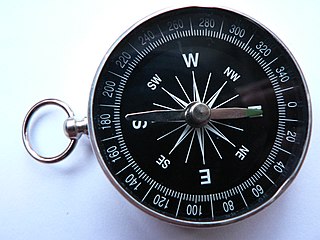
A compass is an instrument used for navigation and orientation that shows direction relative to the geographic cardinal directions. Usually, a diagram called a compass rose shows the directions north, south, east, and west on the compass face as abbreviated initials. When the compass is used, the rose can be aligned with the corresponding geographic directions; for example, the "N" mark on the rose points northward. Compasses often display markings for angles in degrees in addition to the rose. North corresponds to 0°, and the angles increase clockwise, so east is 90° degrees, south is 180°, and west is 270°. These numbers allow the compass to show magnetic North azimuths or true North azimuths or bearings, which are commonly stated in this notation. If magnetic declination between the magnetic North and true North at latitude angle and longitude angle is known, then direction of magnetic North also gives direction of true North.

The north and south celestial poles are the two imaginary points in the sky where the Earth's axis of rotation, indefinitely extended, intersects the celestial sphere. The north and south celestial poles appear permanently directly overhead to observers at the Earth's North Pole and South Pole, respectively. As the Earth spins on its axis, the two celestial poles remain fixed in the sky, and all other celestial points appear to rotate around them, completing one circuit per day.
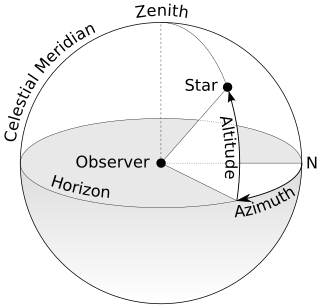
The horizontal coordinate system is a celestial coordinate system that uses the observer's local horizon as the fundamental plane. It is often used to specify a location in the sky using elevation and azimuth angles. However, in general a location can include range or can be specified using any coordinate system, such as Cartesian coordinate system.

North is one of the four compass points or cardinal directions. It is the opposite of south and is perpendicular to east and west. North is a noun, adjective, or adverb indicating direction or geography.
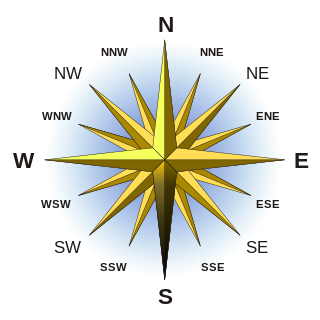
South is one of the cardinal directions or compass points. South is the opposite of north and is perpendicular to the east and west.

The four cardinal directions, or cardinal points, are the directions north, east, south, and west, commonly denoted by their initials N, E, S, and W. East and west are perpendicular to north and south, with east being in the clockwise direction of rotation from north and west being directly opposite east. Points between the cardinal directions form the points of the compass.

Magnetic declination, or magnetic variation, is the angle on the horizontal plane between magnetic north and true north. This angle varies depending on position on the Earth's surface and changes over time.

A geographical pole or geographic pole is either of the two points on Earth where its axis of rotation intersects its surface. The North Pole lies in the Arctic Ocean while the South Pole is in Antarctica. North and South poles are also defined for other planets or satellites in the Solar System, with a North pole being on the same side of the invariable plane as Earth's North pole.

Alexander Johan Hjalmar Skarsgård is a Swedish actor. He is best known for his roles as Brad "Iceman" Colbert in the miniseries Generation Kill (2008), Eric Northman in the television series True Blood (2008–2014) and Perry Wright in the television series Big Little Lies (2017–2019). The lattermost earned him several accolades, including a Primetime Emmy Award, a Golden Globe Award and a Screen Actors Guild Award. He has also appeared in the films Melancholia (2011) and The Legend of Tarzan (2016).

A (geographic) meridian is the half of an imaginary great circle on the Earth's surface, terminated by the North Pole and the South Pole, connecting points of equal longitude, as measured in angular degrees east or west of the Prime Meridian. The position of a point along the meridian is given by that longitude and its latitude, measured in angular degrees north or south of the Equator. Each meridian is perpendicular to all circles of latitude. Meridians are half of a great circle on the Earth's surface. The length of a meridian on a modern ellipsoid model of the earth has been estimated at 20,003.93 km.
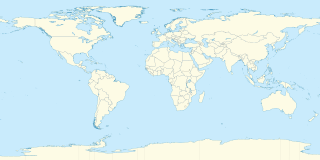
The 45th parallel south is a circle of latitude that is 45° south of the Earth's equator.

Polheim was Roald Amundsen's name for his camp at the South Pole. He arrived there on December 14, 1911, along with four other members of his expedition: Helmer Hanssen, Olav Bjaaland, Oscar Wisting, and Sverre Hassel.
The cataclysmic pole shift hypothesis is a fringe theory suggesting that there have been geologically rapid shifts in the relative positions of the modern-day geographic locations of the poles and the axis of rotation of the Earth, creating calamities such as floods and tectonic events.
True north is the direction along Earth's surface towards the geographic North Pole or True North Pole.

There exists a wide range of secular Christmas stories, told in popular music, on television, and in the cinema, that are told about the Christian holiday of Christmas, that may be based on or allegorize the biblical Christian mythology of Christmas, as the birth of Jesus, but not necessarily. The stories may also have newer interpretations and introduce new characters. These secular Christmas stories could be classified as mythopoeia, or Christian allegories.
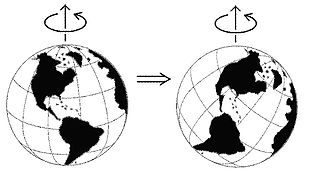
True polar wander is a solid-body rotation of a planet or moon with respect to its spin axis, causing the geographic locations of the north and south poles to change, or "wander". If a body is not totally rigid, then in a stable state, the largest moment of inertia axis will be aligned with the spin axis, with the smaller two moments of inertia axes lying in the plane of the equator. If the body is not in this steady state, true polar wander will occur: the planet or moon will rotate as a rigid body to realign the largest moment of inertia axis with the spin axis.

Polar exploration is the process of exploration of the polar regions of Earth – the Arctic region and Antarctica – particularly with the goal of reaching the North Pole and South Pole, respectively. Historically, this was accomplished by explorers making often arduous travels on foot or by sled in these regions, known as a polar expedition. More recently, exploration has been accomplished with technology, particularly with satellite imagery.

The North Magnetic Pole is a point on the surface of Earth's Northern Hemisphere at which the planet's magnetic field points vertically downwards. There is only one location where this occurs, near the Geographic North Pole. The Geomagnetic North Pole, a related point, is the pole of an ideal dipole model of the Earth's magnetic field that most closely fits the Earth's actual magnetic field.
















